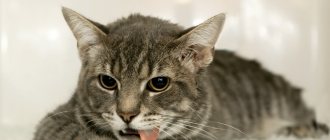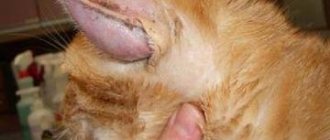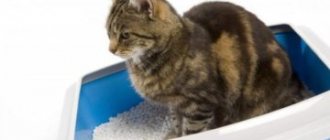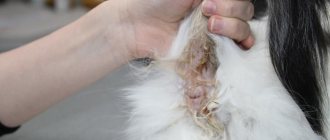Cats have long conquered the human race with their grace and tenderness. They live in all corners of our planet. Whatever dog breeders may say about canine friendship and devotion, cats are still the most common four-legged pets on earth. This creature is gentle, affectionate and completely self-sufficient; caring for such an animal is kept to a minimum and does not cause much trouble. Perhaps the only feature of the cat family that can cause difficulties is their reproductive function. During puberty, young seals begin to mark their territory and show excessive agility. With cats, everything happens a little differently; although they do not mark their territory, during the onset of estrus they behave quite noisily.
The cat makes loud guttural sounds, notifying the entire neighborhood for several days that it is time for a “cat wedding,” while giving sleepless nights to its loving owners. But this is not the only problem that purr lovers may encounter. The reproductive organs of cats are very vulnerable, and they can easily develop gynecological problems. Pyometra in cats is one of the most common and serious. Every breeder of purring beauties definitely needs to know what it is, what the dangers are and how to protect your pet from it.
What is pyometra
Pyometra is an inflammatory process that occurs inside the uterus and is accompanied by the accumulation of pus. In most cases, pathologies of the genital organs in animals are hormone-dependent. Estrogen and progesterone, acting in high doses on the endometrium each cycle, contribute to the production of mucus, which is a favorable environment for the proliferation of bacteria. Under natural conditions, such a process does not exist, so pyometra is a problem for domestic animals. A regular increase in hormonal levels without conception in pets leads to the appearance of cysts and the proliferation of pathogenic organisms in the uterine cavity.
Pathogenesis of pyometra
Pyometra is a disease of the reproductive organs of a cat, accompanied by inflammatory processes followed by the release and accumulation of pus in the uterus.
The hormones progesterone and estrogen have a huge influence on the development of pathology. During the sexual cycle, they provoke the release of large amounts of mucus in the uterus.
Over time, mucus becomes a breeding ground for bacteria.
Excess hormones prevent the outflow of excess mucus from the uterine cavity, and leukocytes aimed at protecting the uterus reduce their activity due to concern for potential sperm, which these same leukocytes can destroy.
Causes of the disease
The disease occurs due to bacteria entering the genital tract, as well as due to hormonal imbalance. The following causes of pyometra in cats can be identified:
- Empty heats. If a cat goes through periods of estrus for a long time without mating, then over time this leads to a serious hormonal imbalance. Therefore, if the owners do not plan to reproduce the pet, then it is better to sterilize the animal.
- Using anti-estrus pills. Often, pet owners give their cat hormones to stop it from screaming and begging for a cat. However, continuous use of such drugs is extremely harmful. This can cause malfunction of the gonads. Cystic changes occur in the uterus, and then pyometra.
- Hypothermia during estrus. During this period, the cat’s body is vulnerable to all adverse effects. Due to decreased immunity, the animal becomes susceptible to infections.
- Poor hygiene during childbirth. If a cat gives birth to babies in unsanitary conditions, the infection easily penetrates the uterus.
- Mating with an untested cat. A cat can get an infection during mating. This often happens if the cat has prostatitis or other genitourinary infections. Uncontrolled matings with street animals are especially dangerous.
- Other infections of the genitourinary system. With cystitis, vaginitis or cervicitis, bacteria can enter the uterus from other organs.
- Chlamydia. With this disease, chlamydia can enter the uterus through the bloodstream.
Causes of the disease
The main reasons contributing to the development of pyometra include:
- hormonal disorders and decreased immunity;
- unsanitary conditions during the birth of kittens;
- taking medications to animals to prevent the onset of estrus;
- incompletely cured genitourinary pathologies;
- uncontrolled or mating with unexamined males.
It has been noted that the disease most often develops in animals that have given birth over the age of five years, and in nulliparous animals over the age of three years. Often, pyometra can be the result of complications after childbirth or termination of pregnancy, or injuries to the pelvic bones.
Factors influencing the appearance of pyometra
The causes of pyometra include:
- Low immunity;
- Hormonal imbalance;
- Abuse of drugs to interrupt estrus;
- Unsanitary conditions during lambing;
- Pathologies of the genitourinary system (cystitis, vaginitis, endometritis) that can spread the inflammatory process in the uterus
- Disorderly matings;
- Maturity in cats (over 5 years of age) increases the likelihood of developing pyometra.
Pyometra can become a complication after a difficult lambing, injuries to the pelvic organs, or after termination of pregnancy. Frequent births of a cat can become an additional factor in the appearance and development of the disease.
What causes
The following reasons lead to pyometra:
- infection entering the genital organs after childbirth under unsanitary conditions or against the background of various postpartum complications;
- infectious pathologies of the urinary system that have spread to the uterus;
- lack of hygiene during estrus;
- hormonal disruptions while taking hormonal medications to interrupt or prevent estrus, taken for a long time and/or in violation of dosage regimens;
- hormonal imbalance against the background of empty estrus (cycles without mating and fertilization in the state of “overstaying/overshooting”).
- spontaneous mating with street “unsterile” cats;
- pathological or congenital hypo- or atony of the muscular walls of the uterus, provoking stagnation in the cavity of the natural secretion of the uterine mucosa;
- abdominal operations in the pelvic area, leading to scars and pathological fusion of the cervical canal of the uterus;
- tumors that grow, decompose and at the same time block the exit from the uterus, limiting the outflow of pathological secretions;
- pelvic injuries.
As practice shows, absolutely all cats are at risk, regardless of age and history of childbirth. Females who have given birth get sick with the same frequency as nulliparous females, and old ones just like young ones. The difference can only be in the severity of the flow.
Why does it occur
The occurrence of pyometra is influenced by:
- Genetic predisposition. Some cats have elevated levels of the hormones estrogen and progesterone. Because of this, at a certain stage of life, the pussy develops cystic hyperplasia. This pathological phenomenon, combined with a weakened immune system, leads to the development of pyometra.
- Long-term use of certain medications. The risk of developing the disease increases if the pet has received frequent therapy with antibacterial drugs or antiseptics from the hormonal group.
- The presence of pathogenic microflora in the body. The infection can occur during surgery, during mating or during childbirth.
Factors provocateurs. The above reasons are the main ones. However, for the disease to develop, the influence of accompanying factors is necessary:
- the presence of uterine atony;
- difficult childbirth, which was accompanied by trauma to the birth canal;
- bladder infections.
Cats whose owners give them medications that suppress hormonal levels during estrus and suppress sexual desire are susceptible to developing an infectious disease of the uterus.
Disease prevention
Routine sterilization of all cats that are not of breeding value is a 100% effective method of combating pyometra. Sterilization is also indicated in cases where hormonal disorders are diagnosed, pathologies of the uterus and/or ovaries are detected, a chronic disease that makes it undesirable to obtain offspring from a cat, that is, almost any chronic disease. Since the treatment of pyometra in a cat in most cases comes down to the same sterilization, it is wiser not to wait for a dangerous condition, since in the case of emergency surgery the risks of complications are much higher.
If the cat is not sterilized, veterinarians recommend an ultrasound examination every year. Also, you should not use hormonal drugs that shift the timing of estrus unless absolutely necessary. During a cat’s heat period, you should not attend exhibitions, and it is recommended to breed it only with trusted representatives, if you have all the certificates that the male has no infections or other diseases of the genitourinary system. In case of any uncharacteristic discharge from the genitals, immediately show a doctor, undergo a clinical examination and examination, since in the early stages of the pathology it is easier to treat than to lead to surgery.
Complications
Pyometra is a severe inflammatory disease of the uterus, leading to the development of:
- abscess of the abdominal organs;
- acute peritonitis;
- rupture of the uterine cavity.
Complications may arise after surgical treatment of pyometra if the doctor left even a small fragment of the ovary. This leads to relapse of the disease with the development of an infectious-inflammatory process in the abdominal organs. In the absence of timely treatment due to complications, the disease leads to the death of the pet.
Also watch the video symptoms and treatment of pyometra:
Symptoms of the disease
In cats, purulent pyometra develops quite quickly, and the first signs of the disease appear a couple of months after the end of estrus. During this time, harmful bacteria actively multiplied in the uterine cavity, which often become sources of various infectious diseases. One of them is considered to be pyometra in cats, the symptoms and treatment of which directly depend on the form of this pathology.
Pyometra in cats can be open or closed, and each of these forms has its own symptoms.
Diagnosis of the disease
If you suspect a pathological process in the uterus of an animal, you must immediately contact a specialist. The pet is prescribed an ultrasound, during which the doctor examines the condition of the diseased organ - as pathology develops, the size of the uterus increases significantly, its walls thicken, and cysts are visible on the surface. The animal's blood is also analyzed. With pyometra, increased urea, leukocytosis, and hyperglobulinemia are observed. Protein is found in the urine.
If the development of pyometra is suspected, the animal is subjected to ultrasound examination.
About therapeutic techniques
So, how is uterine inflammation in cats treated? Let us immediately note that at the slightest sign of pyometra, when the uterus is completely filled with pus and its cervix is closed, it is better to immediately think about the complete removal of both this organ and the ovaries, regardless of how high the breeding value of the animal is. Most likely, even with a successful outcome, the animal will still remain infertile. Practice shows that even slightly advanced cases of purulent inflammation of the uterus are difficult to cure with medication, so surgery is sometimes the animal’s only chance for life. However, let's not talk about sad things.
Most often, endometritis is treated. Glucose, Ringer, and other compounds are administered intravenously to help relieve intoxication and support the life of the cat, which probably does not suffer from increased appetite. The main method of treatment is antibiotic therapy. True, before using antibacterial agents, it is vitally important to sow the material on a nutrient medium and accurately determine the type of pathogenic organism.
In this case, you can find out exactly what kind of antibiotic can be used to destroy it, without wasting time on pointlessly stuffing the cat with potent drugs. The sick animal is provided with a sufficient amount of clean drinking water. They try to feed them with broths and other foods that do not strain the digestive tract.
Diagnosis of pyometra
- Particular attention is paid to the composition of the cat's blood. With pyometra, the analysis shows leukocytosis, hyperproteinemia, a shift in the leukocyte formula to the left, hyperglobulemia, and a high level of urea in the blood (40-300 mg).
- A urine test will show proteinuria (high protein levels).
- Palpation of the abdomen, depending on the fatness of the animal and other factors, can reveal uterine horns enlarged several times, sausage-shaped or with ampulla-shaped extensions.
- The most reliable method of diagnosis is ultrasound of the uterus. Together with laboratory tests, it allows you to make the correct diagnosis in 100% of cases. In ultrasound images, the uterus will be enlarged in size and the uterine cavity will be filled with fluid.
- Biomaterial is also collected using a vaginal smear and examined for bacteriological culture.
Treatment of pyometra
If a cat is diagnosed with pyometra, drug therapy may be prescribed, but a more effective way to get rid of the problem is surgery.
The advantage of conservative therapy is that the animal retains the ability to bear offspring.
Drug therapy
Medicines can only help with the open form of the pathology, and even then not always. With this treatment there is a risk of relapse. Complex therapy for inflammation is aimed at removing purulent masses, getting rid of bacteria and increasing the body's resistance. Experts prescribe the following categories of drugs:
- Hormonal. Oxytocin or Prostaglandin are usually used - they cause the uterus to contract, which helps remove pus.
- Antibiotics. Brulamycin, Amoxicillin, Cloprostenol to get rid of pathogenic microflora.
- To enhance immunity. A specialist may prescribe Immunofan or Ribotan as immunomodulators.
If there are no positive changes, the doctor should insist on surgery.
Surgery
The surgical method, which involves removing the uterus and ovaries, is considered the most effective for ridding an animal of pyometra. The operation is performed under general anesthesia and if assistance is provided in a timely manner, the likelihood of a complete recovery is very high. In the case of a closed form of pathology, specialists, in most cases, immediately prescribe surgery.
Removing the uterus and ovaries is an effective way to get rid of pyometra
If the owner did not purchase the animal for breeding, then it is better to castrate it. This is the best measure to prevent the development of pyometra.
Diagnosis of pyometra
Diagnosis of pyometra in cats is carried out using several methods, which include:
- general examination by a veterinarian and palpating the animal’s abdomen;
- blood and urine tests, the results of which will show the presence of severe purulent inflammation of the uterine cavity;
- an x-ray, which is carried out only with a closed type of pyometra, since with an open type it will not give results due to the removal of purulent exudate from the uterine cavity;
- Ultrasound examination, which is the most informative method. Pyometra in a cat is detected immediately by ultrasound, and it also allows the doctor to exclude a possible pregnancy and see whether the inflammatory process has affected other internal organs.
After the examination, the specialist confirms or denies purulent inflammation of the uterus. If it is at the initial stage, then drug treatment is prescribed, but if the pyometra is of a closed type or has become chronic, the animal is prescribed surgery to remove the uterus and ovaries.
Prevention
If your pet has not yet undergone the sterilization procedure or is of breeding value, you should carefully take care of its health. It is always easier to prevent a disease than to treat it and deal with its consequences. Make it a habit to visit your veterinarian regularly. Remember that immunity is the guardian of health, so high-quality nutrition and vitamins must be present in the diet. During the period of heat, try to protect your purr from stress and carefully consider the choice of a potential “groom”. Use contraceptives with extreme caution and strictly follow the recommendations. Be attentive to your pet, because many diseases can cause the appearance of a disease such as pyometra in cats. Treatment of all kinds of diseases should be completed, strictly adhering to the doctor’s instructions. If your cat is diagnosed with pyometra, begin intensive care immediately! This is a very complex disease, but if you seek help in a timely manner, the outcome can be quite successful.
Medicinal treatment without surgery
When diagnosing pyometra in cats, its treatment without surgery is possible, although recently this has been considered ineffective. The method consists of attempting non-surgical intervention with the help of hormonal drugs, antibiotics and symptomatic therapy to cleanse the uterine cavity of the pus accumulated in it.
Hyperthyroidism in cats: methimazole, symptoms and treatment
Hormonal drugs are usually prescribed to block the effect of the hormone progesterone on the uterus (for example, alysine).
Important! The earlier the disease is diagnosed, the greater the chances of saving your pet without surgery. But there is no guarantee that the inflammatory process will not recur after the next heat.
Treating pyometra without surgery is a rather risky and expensive method. It is usually used for early detection and uncomplicated course of the disease, as well as in cases where we are talking about purebred and expensive cats from which they are still planning to get kittens. But it should be remembered that even in the case of a positive outcome of the disease, the cat may remain infertile.
Treating pyometra with medication is quite risky; the disease can recur at any time
If the cat’s uterus has not been removed, then after complete recovery and a course of restorative therapy, provided that the histology performed is normal, veterinarians advise not to delay mating the animal in order to produce offspring. After all, there are no guarantees that the disease will not recur and this time urgent sterilization will not be required.
Among the folk remedies prescribed for pyometra, chamomile, calendula, and nettle are usually used. But decoctions of the listed herbs in no case can act as the only and independent remedy for the disease. They are taken along with the main treatment (medical or surgical), and their main functions are to help relieve pain and inflammation, as well as restore the structure of damaged tissues.
Note! Under no circumstances should you self-medicate, even if there are obvious symptoms or the disease appears to the owner to be mild. If your animal feels unwell, you must contact a veterinarian, otherwise you may kill your pet.
Caring for an animal after surgery
Competent postoperative care for the animal is very important to prevent the development of complications and the speedy restoration of normal functioning. The pet owner must:
- for the first time after surgery, to prevent the animal from licking the stitches, dress it in a blanket;
- regularly inspect the stitches and if redness and inflammation appear, immediately visit a veterinarian;
- feed the cat liquid and semi-liquid foods, do not forget about a sufficient amount of water in the bowl.
If you suspect a deterioration in your pet's condition, you should not postpone a visit to the doctor.
Diagnosis and treatment
As a rule, the appearance of bloody discharge in the cat causes owners to contact their veterinarian. Other symptoms may not occur in the early stages of the pathological process.
The doctor must obtain reliable information from the owners that would confirm or deny the presence of the disease in the pet. Usually, cat owners confirm that their pet has recently begun to drink more and move less, and that there have been no kittens for a very long time.
The doctor’s next steps are to conduct a laboratory test, as well as a visual examination.
Pyometra provokes a significant increase in the number of globulins and leukocytes in the blood. A greatly reduced urine concentration in an animal is a consequence of the pathogenic effect of infection on the kidneys. However, all these changes may indicate other diseases in the body caused by bacteria. Therefore, it is necessary to conduct a comprehensive and comprehensive examination.
You can examine the boundaries of a swollen uterus with a closed cervix using ultrasound and x-rays.
When a diagnosis of pyometra is made, surgery is the preferred method of treating the pathology. Even in the early stages of inflammation, it is better not to take risks and immediately undergo surgical removal of the reproductive organs. Such a radical method is necessary in order to prevent a possible relapse of pyometra. But even in this case, there is no one hundred percent guarantee that the disease will not return.
At the vet
When treating pyometra at an early stage, when the cervix is still open, the pet is sent home for rehabilitation the very next day after surgery. In an advanced situation with a closed uterus and the presence of a large number of purulent accumulations, treatment in a hospital setting will last a week or even more. During this time, rehabilitation and drug therapy will be carried out. The latter includes treatment with antibiotics.
Additionally, there are also alternative treatments for pyometra. All of them provide exclusively conservative therapy without surgical intervention. In this case, there is no talk at all about the absence of relapses and the complete cure of the pet. The alternative is most often resorted to by owners of purebred animals from whom they expect to produce offspring in the future.
If a disease occurs, the pet is given prostaglandins. This is a group of hormones that promote relaxation and dilatation of the cervix. Also, due to the effect of the drug, the uterus contracts and pushes accumulated pus into the external environment.
How is pyometra diagnosed?
Cats that are examined early in the disease may have mild vaginal discharge without any other signs of illness. However, as the disease progresses, pyometra becomes noticeable in most cats. Any sick cat drinks a lot of water and, unless the cat is spayed, pyometra should be immediately suspected, especially if there is vaginal discharge or a painful, enlarged abdomen.
A cat with pyometra will have an increased number of white blood cells and globulin, a protein associated with the immune system. The specific gravity (concentration) of urine is very low due to the toxic effects of bacteria on the kidneys. However, these changes are not specific and can occur in any cat with a serious bacterial infection.
If the cervix is closed, an x-ray of the abdomen will show an enlarged uterus. If the cervix is dilated, the enlargement of the uterus will be slight and will not appear on the x-ray. An ultrasound examination will help identify an enlarged uterus and distinguish it from pregnancy.
Prevention of pyometra
You can be sure that the cat is insured against the development of pathological processes in the uterus only if it is castrated. If the animal is used for breeding, then this measure is undesirable for the owner. Those who want to preserve the reproductive function of their pet will have to adhere to certain rules and work hard, namely:
- do not use hormonal drugs to suppress heat;
- Perform ultrasounds regularly;
- carry out matings only with carefully examined males;
- provide sterile conditions for the birth of offspring;
- take care of prompt veterinary care in case of excessively long or pathological lambing;
- Monitor discharge from the cat’s genitals and, if present, immediately contact a specialist.
Sometimes, to prevent the development of pyometra, specialists prescribe antibacterial and hormonal agents.
Caring for a cat after pyometra
No matter how the treatment is carried out, with the help of surgeons, or therapeutically in a hospital, such extensive purulent inflammation of the internal organs requires a long course of antibiotics (tablets for oral administration or a solution for intramuscular or subcutaneous injection).
Perhaps the veterinarian will prescribe some kind of symptomatic or infusion therapy, based on the severity of the symptoms of the disease, as well as local treatment of sutures on the skin of the cat’s abdomen and wearing a protective blanket to prevent licking.
How does the disease manifest itself?
The first symptoms of pyometra in a cat begin with general malaise:
- the animal is constantly lying down
- eats practically nothing
- drinks a lot of water, which may be associated with a rise in body temperature,
- before our eyes he is losing weight and weakening,
- the coat becomes disheveled and dull.
A cat licks vaginal discharge.
Specific signs of pyometra in a cat include:
- enlargement of the abdomen, sometimes the female becomes like a bloated barrel;
- abundant purulent discharge from the vaginal loop, it smells bad, the consistency resembles cream, and has a dirty milky color;
- The discharge is not constant: it either stops or resumes.
Important! A long course of the disease provokes the formation of a cancerous tumor, so treatment of pyometra in a cat cannot be delayed.
Symptoms of purulent inflammation of the uterus
Symptoms of pyometra in a cat usually appear four weeks after ovulation, but they can occur early and not be noticeable. As the inflammatory process increases, the animal’s condition worsens and it begins to consume more water. Often, owners notice health problems only when the cat begins to have vaginal discharge.
But only open pyometra in a cat manifests itself this way; when it is closed, there is no discharge, and if it is not diagnosed in time, such a dangerous pathology as peritonitis develops, often leading to the death of the pet.
Closed pyometra is represented by the following symptoms:
- depressed state;
- drowsiness;
- deterioration of appetite, which over time leads to exhaustion and anorexia;
- polyuria. The animal produces an increased amount of urine. This indicates a serious impairment in the functioning of the kidneys;
- pathological thirst. Polydipsia develops due to intoxication, which affects the central nervous system, kidneys and endocrine system. It can also manifest itself as a result of an increase in temperature.
- vomiting;
- enlargement of the abdominal area;
- increased temperature due to the inflammatory process in the uterus;
- septicemia, which develops due to the rapid proliferation of dangerous microorganisms in the bloodstream;
- strong stretching of the uterine walls as a result of filling it with pus. If untimely assistance is provided, the uterus can rupture or become saturated with pus and cause peritonitis, which can be fatal.
The following symptoms are characteristic of open pyometra:
- bloody leads;
- mucopurulent discharge of a grayish tint with the smell of decomposition.
The good thing about the open form of pyometra in cats is that the discharge leaves the uterine cavity - this prevents peritonitis and rupture.
To avoid serious complications or death of the animal, if at least one of the above symptoms appears, the cat should be immediately taken to the veterinarian.
Causes of pyometra in cats
There are two main reasons for the occurrence of this disease:
- Conditions that promote the development of bacteria in the uterus in the first couple of months after estrus. Due to an increase in progesterone, the thickness of the mucosal walls increases. If pregnancy does not occur, there is a risk of a cyst developing, which will secrete fluid and pus, which accelerates the development of bacteria. And the leukocytes that protect the cavity do not work.
- Excessive use of drugs containing hormones. Because of this, some changes occur in the uterus. Estrogen enhances the effects of progesterone, which causes inflammation.
If your pet is spayed, the risk of developing pyometra is very low.
How do bacteria get into the uterus?
The cervix is the entrance to the uterus. The cervix is usually tightly closed except during estrus, when it opens to allow sperm to enter the uterus.
If the cervix is dilated or relaxed, bacteria can easily enter the uterus.
If the cervix is dilated or relaxed, bacteria that are normally found in the vagina can easily enter the uterus. Under normal conditions, the uterine environment is not conducive for bacterial survival, but if the uterine wall is thickened or cystic, it creates ideal conditions for bacterial growth. Additionally, under these conditions, the uterine muscles cannot contract due to thickening of the uterine wall or increased levels of progesterone. This means that the uterus is not able to “push out” bacteria that enters it.
Post-operative care for your pet
After surgery, a pet, like a person, needs special care. To do this, it is recommended to comply with a number of requirements, namely:
- immediately put on a post-operative blanket - this is necessary so that the animal cannot chew the stitches;
- follow a veterinary diet when feeding - food should be soft or semi-liquid. This could be chicken broth with chopped pieces of meat or various meat pates;
- At first, your pet may experience a lack of appetite; this is normal. However, you need to ensure that the animal always has water;
- The postoperative suture must be inspected daily. If it becomes inflamed or red, the cat should be taken to the vet immediately.
To facilitate the rehabilitation period, you can use medications to promote a speedy recovery. As a rule, they are prescribed:
- Traumatin - effectively eliminates the consequences of intoxication of the body;
- aluminum - a spray with an anti-inflammatory effect, intended for treating wounds and seams;
- Roncoleukin is a prophylactic agent that promotes rapid tissue regeneration;
- hemobalance - prescribed to restore liver function, digestive and hematopoietic processes;
- Imunofan is an anti-inflammatory drug that also eliminates the side effects of other drugs;
- ASD 2 is an effective antiseptic. The drug is used with caution, as an overdose can cause intoxication.
Before taking any medication, you should consult a veterinarian about the advisability of use and clarify the dosage of the drugs.
Diagnostics
A comprehensive examination allows you to establish the fact of the disease. After a clinical and vaginal examination, as well as palpation of the peritoneum, the caudate patient will be sent for an ultrasound and x-ray of the pelvic organs. These studies will help exclude pregnancy and determine the degree of filling of the uterus with pus.
A blood test should show an increased concentration of white blood cells (an indicator of infection in the body and kidney failure) and hyperglobulinemia. A urine test will detect a decrease in urea of up to 300 mg (a sign of toxins entering the kidneys and ureters).
Symptoms
Signs of pyometra can be noticed approximately 2-4 weeks after estrus, and most often the disease begins acutely, with pronounced symptoms.
The main manifestations of the pathology are as follows:
- discharge from the loop of a brownish or cloudy white color with a thick consistency and unpleasant odor (occurs only when the cervix is open);
- lack of appetite, accompanied by severe thirst, vomiting, diarrhea;
- frequent urination;
- enlargement of the abdomen, uterus and genital organs, which can be noticed during visual inspection and palpation;
- deterioration in general health, fever, apathy or increased aggression.
Sometimes the disease develops so rapidly that the animal can die in a matter of days - the volume of purulent exudate reaches a liter in just a day, as a result of which the walls of the uterus rupture due to increased pressure, and fluid fills the abdominal cavity.
The owner of the animal may not pay attention to the symptoms and this can lead to the decline of the cat.
When the cervix is closed, the course of the disease can be hidden - the cat looks lethargic and apathetic, avoids active games and loses appetite, the coat becomes dull and disheveled. She can lick her belly often and for a long time, and when she tries to palpate or simply touch it, she shows great anxiety. If any of the above symptoms develop, you should immediately take the animal to a veterinary clinic, otherwise it may die.
Clinical picture of pyometra
Clinical observations suggest that the development time of pyometra can vary from several days to 2–6 months.
When the cervix is open, the cat develops strong purulent vaginal discharge, and the animal licks itself frequently and diligently. In the places where the cat lay, wet spots are noticeable. The discharge has a bloody or cloudy white color and an unpleasant, putrid odor. When the cervix is closed, there is no discharge or only a slight smear.
The animal completely or partially refuses to eat, the cat drinks a lot and greedily, and the body temperature rises. The general condition worsens, the animal becomes apathetic, moves little and does not respond to external stimuli, breathing is heavy, vomiting appears, in some cases diarrhea begins, the abdomen increases in size due to the accumulation of fluid and pus in the uterine cavity, becomes painful and tight, the fur becomes ruffled and fades and becomes tangled. With advanced pyometra, signs of intoxication and sepsis may be observed, when ulcers and metastatic abscesses appear on the body and organs of the animal.
Postoperative care
Comprehensive home care is important in treating a cat after pyometra surgery. It assumes:
- timely use of medications prescribed by a doctor;
- compliance with a restorative diet (puree and liquid foods are required) and drinking regimen;
- constant contact with the veterinarian monitoring the cat after removal of the pyometra;
- increased attention to any changes in the pet’s appetite, urination, activity, mood - to everything that can serve as useful information for the attending physician;
- daily inspection and treatment of surgical sutures;
- contacting a veterinarian if there is suppuration or divergence of the sutures, as well as if discharge appears in the cat after removal of the pyometra (they may indicate remaining or new problems in the genital organs).










